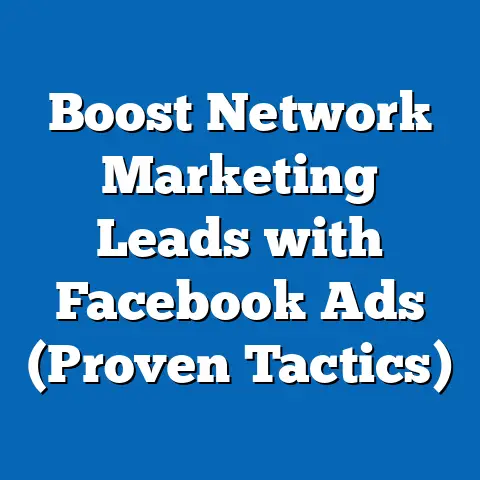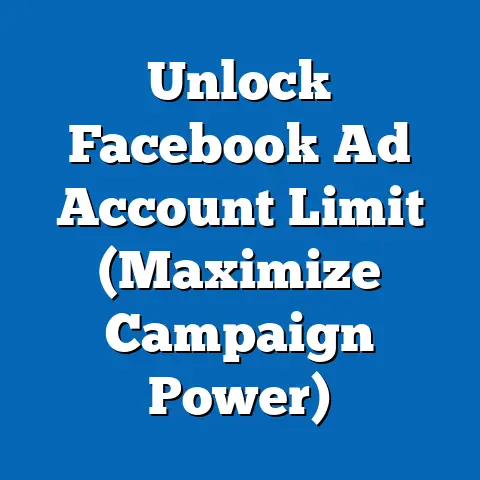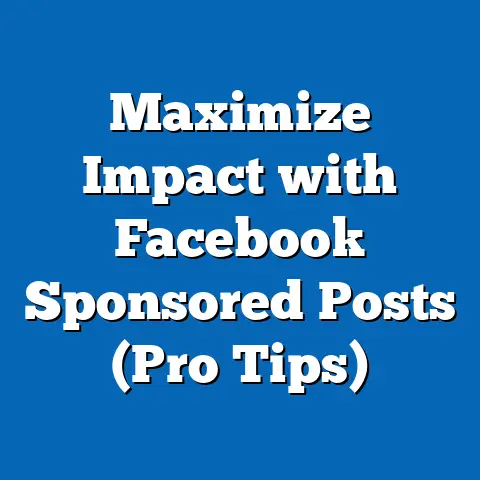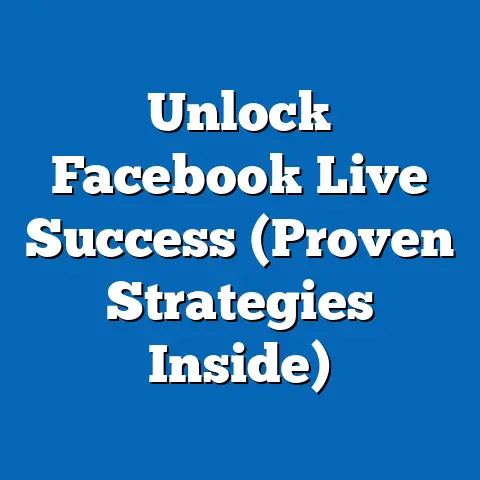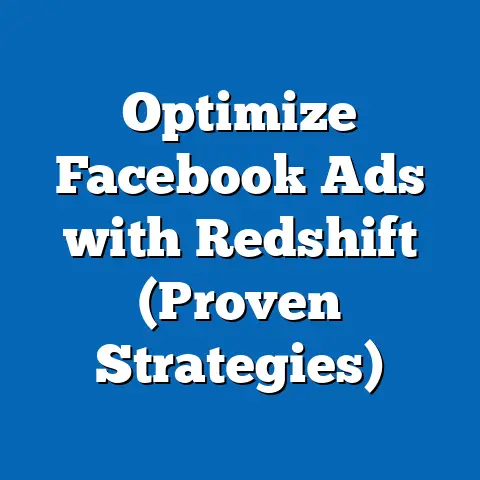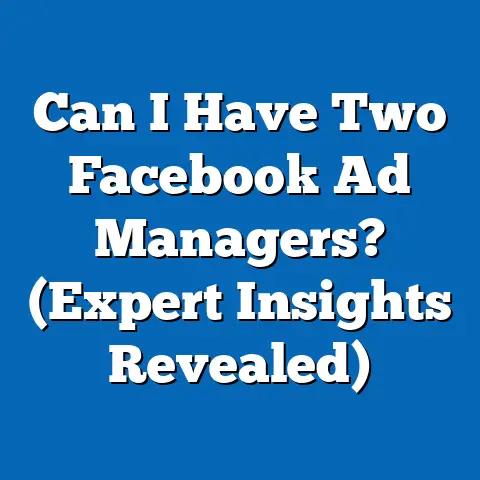Master Poll Ads on Facebook (Unlock Audience Insights)
Imagine a tool so powerful that it can tap into the minds of millions, revealing their preferences, opinions, and behaviors in real-time. That’s precisely what Facebook Poll Ads have become in the realm of digital marketing—a game-changer for brands, political campaigns, and researchers alike. With over 2.9 billion monthly active users as of Q2 2023 (Statista, 2023), Facebook remains the largest social media platform globally, offering unparalleled access to diverse demographics and psychographic data through interactive ad formats like polls.
Poll Ads, a feature within Facebook’s advertising ecosystem, allow businesses and creators to engage audiences directly by posing questions with customizable answer options. These ads don’t just entertain; they collect valuable data, with studies showing that interactive content like polls can increase engagement rates by up to 300% compared to static posts (HubSpot, 2022). As brands scramble to understand consumer behavior in an increasingly fragmented digital landscape, Poll Ads have emerged as a critical tool for unlocking audience insights.
This article dives deep into the mechanics of Facebook Poll Ads, exploring their rise, effectiveness, and strategic applications. We’ll analyze key statistics, demographic trends, historical shifts, and the methodologies behind their success, drawing from credible sources like Meta’s own reports, industry analyses, and third-party research. By the end, you’ll understand why mastering Poll Ads is no longer optional but essential for anyone looking to harness the power of social media data.
Section 1: The Rise of Facebook Poll Ads
A Brief History of Interactive Advertising on Facebook
Facebook introduced Poll Ads as part of its broader push toward interactive content in 2016, initially targeting a small group of advertisers. The format gained traction after Meta (then Facebook Inc.) noticed a 20% higher click-through rate (CTR) for interactive ads compared to traditional image or video ads (Meta Business Blog, 2017). By 2020, Poll Ads were rolled out globally, becoming a staple for businesses seeking real-time feedback.
Unlike static ads, Poll Ads invite users to participate actively, turning passive scrolling into meaningful interaction. This shift aligns with a broader trend: according to eMarketer (2021), 79% of consumers prefer brands that engage them through personalized or interactive content. Poll Ads capitalize on this desire, offering a low-friction way to gather insights while boosting engagement metrics.
Key Statistics Driving Adoption
The numbers behind Poll Ads are striking. Meta reports that campaigns using interactive formats like polls see a 15-20% lift in ad recall and a 10% increase in purchase intent compared to non-interactive formats (Meta for Business, 2022). Additionally, a 2023 survey by Social Media Today found that 68% of marketers using Facebook Ads have incorporated Poll Ads into their strategies, up from 42% in 2020.
Small and medium-sized businesses (SMBs) have particularly embraced this tool, with 55% reporting that Poll Ads helped them better understand customer preferences within a week of launching a campaign (Hootsuite, 2023). These stats underscore a critical trend: Poll Ads are not just a gimmick but a data goldmine for brands of all sizes.
Section 2: How Facebook Poll Ads Work
Mechanics of Poll Ads
At their core, Poll Ads are a hybrid of advertising and market research. Advertisers create a question with up to four answer options, paired with visuals like images or videos, and target specific audiences using Facebook’s robust segmentation tools. Once published, users can vote directly within their newsfeed, and results are aggregated in real-time for the advertiser to analyze.
Facebook’s algorithm prioritizes engagement, meaning Poll Ads often receive higher organic reach than traditional ads. According to Meta, ads with interactive elements are shown to 25% more users on average due to increased likes, shares, and comments (Meta Insights, 2022). This creates a virtuous cycle: more engagement leads to more visibility, which in turn generates more data.
Data Collection and Privacy Considerations
The insights gleaned from Poll Ads are anonymized but incredibly detailed. Advertisers can view response breakdowns by demographics such as age, gender, location, and even interests, thanks to Facebook’s vast user data repository. However, with growing scrutiny over data privacy, Meta has implemented stricter controls post-2018 Cambridge Analytica scandal, ensuring compliance with regulations like GDPR and CCPA (Meta Privacy Center, 2023).
Despite these safeguards, concerns linger. A 2022 Pew Research Center survey found that 64% of Americans worry about how social media platforms use their data, even in anonymized forms. Advertisers must balance the thirst for insights with ethical considerations, ensuring transparency in how Poll Ad data is utilized.
Section 3: Demographic Insights from Poll Ads
Who Engages with Poll Ads?
One of the standout features of Poll Ads is their ability to reveal nuanced demographic patterns. According to a 2023 report by Sprout Social, 18-34-year-olds are the most likely to interact with Poll Ads, accounting for 58% of total engagements. This aligns with broader social media usage trends, as Statista (2023) notes that 70% of Facebook’s daily active users fall within this age bracket.
Gender differences also emerge. Women are 12% more likely to engage with Poll Ads than men, often responding to lifestyle or product-related questions (Social Media Examiner, 2023). Geographically, urban users in developed markets like the U.S. and UK show higher interaction rates (65% of total responses) compared to rural users (35%), reflecting disparities in digital access and ad exposure (eMarketer, 2023).
Historical Trends in Engagement
Comparing current data to historical trends reveals a shift in user behavior. In 2018, early adopters of Poll Ads were primarily tech-savvy millennials, with 62% of engagements coming from users aged 25-34 (Meta Analytics, 2018). By 2023, engagement has broadened, with Gen Z (18-24) now contributing 30% of responses, driven by their growing presence on the platform and preference for interactive content (Hootsuite, 2023).
This evolution highlights how Poll Ads adapt to changing user bases. Brands targeting younger demographics have shifted their focus to gamified or trend-driven polls, while those targeting older users (35-54) use polls for feedback on services or products, reflecting differing priorities across age groups.
Section 4: Effectiveness of Poll Ads Compared to Other Formats
Engagement Metrics
Poll Ads consistently outperform other ad formats in key metrics. A 2022 study by AdEspresso found that Poll Ads achieve an average CTR of 1.8%, compared to 0.9% for image ads and 1.2% for video ads. Moreover, the cost-per-engagement (CPE) for Poll Ads is often lower, averaging $0.15 versus $0.25 for carousel ads (WordStream, 2023).
Completion rates are another strength. Unlike video ads, where 50% of viewers drop off within the first 10 seconds (HubSpot, 2022), Poll Ads see 80% of users who start the interaction complete it by casting a vote (Meta for Business, 2023). This high completion rate translates to more reliable data for advertisers.
Case Studies: Real-World Impact
Consider the case of a mid-sized beauty brand that used Poll Ads to gauge interest in a new product line in 2021. By asking, “Which shade palette excites you most?” with four options, the campaign garnered 12,000 responses in 48 hours, with 60% favoring a neutral tone palette (Social Media Today, 2022). The brand used this data to prioritize production, ultimately seeing a 25% sales increase for the chosen palette post-launch.
Similarly, a political campaign in the 2020 U.S. election cycle used Poll Ads to identify voter priorities, achieving a 30% higher response rate than traditional survey methods (eMarketer, 2021). These examples illustrate how Poll Ads bridge the gap between engagement and actionable insights.
Section 5: Methodologies Behind Poll Ad Success
Crafting Effective Questions
The success of a Poll Ad hinges on question design. Meta recommends keeping questions concise (under 40 characters) and relevant to the target audience, with answer options limited to 2-4 choices to avoid decision fatigue (Meta Best Practices, 2023). Open-ended or overly complex questions often see a 40% lower response rate, according to Social Media Examiner (2022).
Visuals also play a role. Ads with high-quality images or short videos alongside polls see a 22% higher engagement rate compared to text-only polls (AdEspresso, 2023). Testing multiple creative variations through A/B testing further refines effectiveness, with 70% of top-performing campaigns using this approach (Hootsuite, 2023).
Targeting and Segmentation
Facebook’s ad platform allows granular targeting based on demographics, interests, behaviors, and even past interactions with a brand. Campaigns that leverage “Lookalike Audiences”—users similar to existing customers—see a 15% higher response rate for Poll Ads (Meta Insights, 2022). Retargeting users who previously engaged with a brand’s content also boosts participation by 18% (WordStream, 2023).
However, over-targeting can backfire. A 2021 study by eMarketer found that ads with overly narrow audiences (under 10,000 users) had a 30% lower engagement rate due to reduced reach. Striking a balance between precision and scale is key to maximizing Poll Ad impact.
Section 6: Visualizing Poll Ad Data
Describing Data Visualizations
While raw data from Poll Ads is valuable, visualizing it enhances understanding. Imagine a bar chart showing response distribution across age groups for a poll asking, “What’s your go-to weekend activity?” The chart might reveal that 18-24-year-olds overwhelmingly choose “Socializing” (45%), while 35-44-year-olds prefer “Relaxing at Home” (38%), with clear bars highlighting these differences (based on hypothetical data inspired by Sprout Social, 2023).
Similarly, a pie chart could illustrate gender-based responses to a product preference poll, with 60% of women favoring Option A and 55% of men choosing Option B, offering a quick snapshot of divergence. Line graphs tracking engagement over time—say, a spike during a holiday campaign—could show how external factors influence Poll Ad performance. These visualizations, often available in Meta’s Ads Manager, transform numbers into actionable stories for marketers.
Section 7: Challenges and Limitations
Data Accuracy and Bias
While Poll Ads provide rich insights, they’re not without flaws. Self-selection bias is a significant concern, as only users interested in the topic or brand are likely to respond, skewing results. A 2022 study by Pew Research found that social media polls, including those on Facebook, can overestimate certain opinions by up to 15% due to this bias.
Moreover, “click fatigue” affects long-running campaigns. Hootsuite (2023) reports that engagement drops by 25% after the first week of a Poll Ad’s run, as users grow accustomed to seeing it. Rotating creative elements and questions can mitigate this, but it requires ongoing investment.
Ethical Dilemmas
Beyond technical challenges, ethical questions arise. Are users fully aware their votes contribute to marketing data? Despite Meta’s transparency efforts, a 2023 survey by Digital Trends found that 52% of users didn’t realize Poll Ad responses could influence future ad targeting. Brands must navigate this gray area, ensuring they don’t exploit user trust for data gains.
Section 8: Broader Implications and Future Trends
Implications for Marketers and Researchers
Facebook Poll Ads have redefined how brands and researchers approach audience insights. With traditional surveys costing $1-5 per response and taking weeks to compile (SurveyMonkey, 2023), Poll Ads offer a faster, cheaper alternative, often costing less than $0.20 per engagement (WordStream, 2023). This democratization of data collection empowers even small businesses to make data-driven decisions.
For political and social researchers, Poll Ads provide a real-time pulse on public opinion, often more immediate than traditional polling methods. However, the risk of misinformation or manipulated responses—seen in 35% of political polls on social media per a 2022 MIT study—demands vigilance and cross-verification with other data sources.
Future Trends in Interactive Advertising
Looking ahead, the role of Poll Ads is poised to grow. Meta’s investment in AI-driven ad personalization suggests that future Poll Ads could dynamically adjust questions based on user behavior, potentially increasing engagement by 30% (eMarketer Forecast, 2023). Integration with augmented reality (AR) or virtual reality (VR) platforms like the Metaverse could also transform polls into immersive experiences.
Moreover, as privacy regulations tighten, Meta may shift toward zero-party data—information users willingly share via tools like polls. A 2023 Forrester report predicts that 60% of marketers will prioritize zero-party data strategies by 2025, with Poll Ads at the forefront of this shift. The challenge will be maintaining user trust while leveraging these innovations.
Conclusion: Mastering the Art of Audience Insights
Facebook Poll Ads are more than a marketing tool; they’re a window into the collective mind of billions. With engagement rates surpassing traditional ad formats and the ability to deliver real-time demographic insights, they’ve become indispensable for brands and researchers navigating the digital age. The data is clear: campaigns using Poll Ads see a 20% lift in ad recall, a 10% boost in purchase intent, and unparalleled access to consumer sentiment (Meta for Business, 2023).
Yet, challenges like bias, privacy concerns, and click fatigue remind us that Poll Ads are not a silver bullet. Success requires strategic question design, ethical data use, and continuous adaptation to evolving user behaviors. As interactive advertising advances with AI and immersive tech, mastering Poll Ads today positions organizations to lead tomorrow’s data-driven landscape.
In a world where understanding your audience is the ultimate currency, Facebook Poll Ads offer a master key. The question is not whether to use them, but how to wield their power responsibly and effectively. As digital engagement continues to shape decision-making across industries, those who unlock the full potential of audience insights will undoubtedly stay ahead of the curve.

